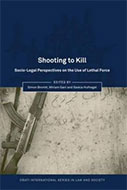Shooting To Kill: Socio-Legal Perspectives On The
Use Of Lethal Force

Editors: Simon Bronitt, Miriam Gani, and Saskia Hufnagel
Publisher: Oxford; Portland, OR: Hart Publishing, 2012. 342p.
Reviewer: Jeremy Horder | May 2013
It is possible, I suppose, to imagine an extraordinary circumstance in which it would be necessary and appropriate under the Constitution and applicable laws of the United States for the President to authorize the military to use lethal force within the territory of the United States” (US Attorney-General Eric Holder, letter of 4th March 2013, to Senator Rand Paul).
Much of the scholarly focus on the legitimacy of the use of lethal force has historically focused on a diet of issues that is in some ways extremely rich, but in other ways rather restricted. There has been no shortage of important questions, which continue to preoccupy theorists: is there a duty to retreat?; is (and if so, when is) self-defence or action-in-prevention-of-crime a permission, justification, exemption or excuse?; can lethal force intentionally be used to negate an imminent threat of rape or serious harm?; does a threat need to be ‘imminent’ before self-defence can lawfully be employed?; what is the relationship between self-defence, the prevention of crime/harm, and the defence of necessity?
However, notwithstanding the richness of the argument bearing on these important questions (see for example the essay by Möller), they have tended to focus quite narrowly on more or less spontaneous individual confrontations, and on dilemmas arising in certain rarified kinds of emergency. The questions have been understood to raise issues about the ethics of state action only where – typically – the defence of necessity is in issue, and it is a matter of medical ethics that is at stake: for example, can doctors benefit patients with good prospects for survival (but in need of emergency treatment to that end) by using those with poor prospects for survival as a resource? In their selection of fascinating essays for this collection, the editors of Shooting to Kill show how scholarly analysis of the subject has moved on.
What these new essays bring to the fore, through what is in fact a multi-disciplinary approach (philosophical, socio-legal, and comparative, for example), is how the ethics of using lethal force raise questions well beyond those raised by moral philosophising about extraordinary individual dilemmas. In particular, addressed in this book are questions about ongoing state policy, from policy decisions by commanders in charge of individual operations (Gordon and Miller, chapter 10) the guidelines issued on the use of force by police and military organisations (Bronitt and Gani, chapter 7), and the question of whether the state even commits a crime when authorising the use of lethal force in — alleged — political emergencies (Campbell, chapter 1; Vincent, chapter 4).
Consider this example: an armed officer intentionally shoots dead a man when the man runs away from a checkpoint when challenged to produce evidence of identification. The officer recognised the man as someone with previous convictions for terrorist offences. The officer seeks to justify his action by saying that he believed that by shooting the man dead he was preventing future murders committed for terrorist ends [AG for Northern Ireland’s Reference (No 1 of 1975)(1977) AC 105). Analysing the claim of justification in a traditional way, one might choose to focus on the element of immediacy or imminence: was the officer preventing an identifiable crime of sufficient seriousness that was about to (soon to be?) be committed?
However, the narrowness of that perspective is betrayed by considering the function of imminence or immediacy requirements. They serve to discourage the pre-emptive use of force when there are harmless alternatives such as escape, or better alternatives such as seeking official protection. Yet, how can such alternative responses make sense in a situation where, in virtue of his or her role, the officer cannot simply abandon his or her duties to ‘escape’, and where the officer is him or herself a member of an authority bound to protect citizens from harm (see the essay by Gordon and Miller)? Inevitably, a full analysis of this kind of situation requires a broader perspective than that provided by a focus on the stereotypical emergency, in which one private individual is confronted by what he or she believes to be an occasion for the use of necessary and proportionate force. It requires analysis in terms of nothing less than a theory of (the limits of) state action in peacetime. Indeed, this example shows that, far from having to imagine a remote ‘extraordinary circumstance’ (to use the US Attorney-General’s words from the passage cited at the outset, above) in which a theory of the limits of state action is required to justify the use of lethal force against citizens, such a theory implicitly guides every officer – police or military – who is authorised to use weapons in carrying out their duties. Such a theory implicitly guides every military or police authority that issues rules and principle to bind or assist its officers, and it also guides executive authorities at the state or national level whose task it is to oversee the work of such executive authorities. In other words, a theory of state action, whether concerned with the use by officials of lethal force or with any action involving a significant encroachment on the rights of citizens, is required to explain and justify not merely the ‘extraordinary’, but also the very ordinary, the normal, the everyday.
In that regard, in Tennessee v Garner [471 U.S. 1 (1985)] the U.S. Supreme Court has indicated that:
Where the officer has probable cause to believe that the suspect poses a threat of serious physical harm, either to the officer or to others, it is not constitutionally unreasonable to prevent escape by using deadly force…[D]eadly force may be used if necessary to prevent escape, and if, where feasible, some warning has been given.
It is not hard to see how, in this passage, the Garner Court struggles to separate issues of general principle (force may be used only where necessary and proportionate) from the ethical elements in what are essentially executive policy considerations, with no credible application to private defence, that should be the subject of public consultation and strategic decision-making: concerning when, for example, a warning should be given, in what form, and by whom (see the essays by Bronitt and Gani, and by Gordon and Miller). Where an officer fails to give a warning, but in so omitting, is only following the guidance issued by his or her police authority for the kind of situation at hand, whose conduct ought to be the principal subject of judicial and scholarly scrutiny: that of the officer, that of the authority, of that of the higher state or national body in charge of the authority? (see the essay by Gordon and Miller).
As Bronnitt and Gani astutely point out in their essay, the question of scrutiny is complicated by the fact that, however much the police may complain that many suspects with knowledge of the legal system ‘exploit ‘ that knowledge to frustrate law enforcement aims, it is in fact the police themselves who benefit most from such knowledge (stemming from their ‘repeat-player’ status). A failure to attend to the power that stems from such knowledge casts a shadow over the viewpoints of those who come close to arguing that, in effect, the police should be given all the power they in good faith think that they need, to meet perceived threats or possible escapes from justice with the use of (deadly) force.
Contrast, in this respect, the language of international law, discussed in fascinating detail by Douglas Guilfoyle and Andrew Murdoch in their essay on the use of force to counter piracy. The International Tribunal for the Law of the Sea has held that, in cases of boarding, stopping or arresting a vessel, international law:
[r]equires that the use of force must be avoided as far as possible and, where…unavoidable, it must not go beyond what is reasonable and necessary in the circumstances. Considerations of humanity must apply…[T]he normal practice…is first to give an auditory or visual signal to stop,…[then to take other action], including the firing of shots across the bows of the ship. It is only after the appropriate actions fail that the pursuing vessel may, as a last resort, use force. Even then, appropriate warning must be issued…and all efforts should be made to ensure that life is not endangered (M/V ‘Saiga’ (No 2) (Saint Vincent and the Grenadines v Guinea) ITLOS Case No 2; (1999) 38 ILM 1323, 1355).
Significantly, it has been found under principles of this kind to be a disproportionate use of force deliberately to sink a vessel, or to hole it with 40mm solid shot, in order to prevent its continued flight (Guilfoyle and Murdoch). There are, of course, significant differences between anti-piracy actions on the high seas, and police actions in prevention of crime or to effect arrests in the street. However, it is the difference in prevailing philosophy that is significant here.
In International law – and indeed, in the jurisprudence of European law (which is perhaps somewhat neglected in this book) — in the shaping of the applicable principles there is an emphasis on what the International Tribunal in MV Saiga (No 2) called ‘considerations of humanity’, and on what might more broadly be referred to as a doctrine of self-restraint, applicable with special force to those performing public duties coupled with powers to use force in the performance of those duties. This is an emphasis conspicuously lacking in Anglo-American courts’ delineation of the limits of the use of potentially lethal force by state officials. The lack likely stems from an unwillingness to recognise that such officials are under co-applicable duties to protect citizens from harm and to uphold the rule of law, duties that are not applicable to ordinary citizens. The unjustified use of force by an officer is all the worse because such an officer is under a duty to protect citizens – including suspected criminals – from harm. That is something that goes to explain why we should expect and require the highest standards of integrity, impartiality, self-restraint and humanity from police officers contemplating the use of force, standards that, as ordinary citizens, we might ourselves struggle to meet. Pity, then, the official (discussed by Kleinig and Tziporah Kasachkoff) who must choose whether to order the destruction of a hijacked plane with 50 innocents on board, or allow it (as he or she knows he or she will be doing, if the order is not given) to be directed by the hijackers to crash into a building with 200 innocent people in it. As the authors so aptly put it (39; their emphasis in the original)), ‘those who occupy positions of power are ordinarily chosen by us to act for us. They take upon themselves burdens that we choose not to bear and perhaps could not stomach’.
In this respect, the important blend of analysis of international and domestic legal rules and principles is one of the most important virtues of the essays in Shooting to Kill, although the collection would have been strengthened by an essay specifically on the position taken by the European Convention on Human Rights (ECHR) in this respect. As Gordon and Miller point out in their essay, the way in which the Convention has been interpreted is much more in line with the approach in International law than with the approach of Anglo-American domestic courts. Under Article 2.2, the way in which – and the occasions on which – force may be used by officials are severely restricted. When using firearms, in particular, the police must act lawfully and only out of ‘absolute necessity’, there must be a balance between the action to be taken and the evil to be prevented thereby, the officers must be accountable for their actions. Further, in considering whether there has been a human rights violation, the court will scrutinise the information gathering and planning stages of any operation to see if adequate opportunities arose to intervene without the use of force. This application of ethical principles not only to an ‘emergency’ itself, but to executive policy both before and after the event, must now be regarded as an essential element of any adequate treatment of shoot-to-kill incidents involving armed officers.
Jeremy Horder is Edmund Davies Professor of Criminal Law, Dickson Poon School of Law, King’s College London.


